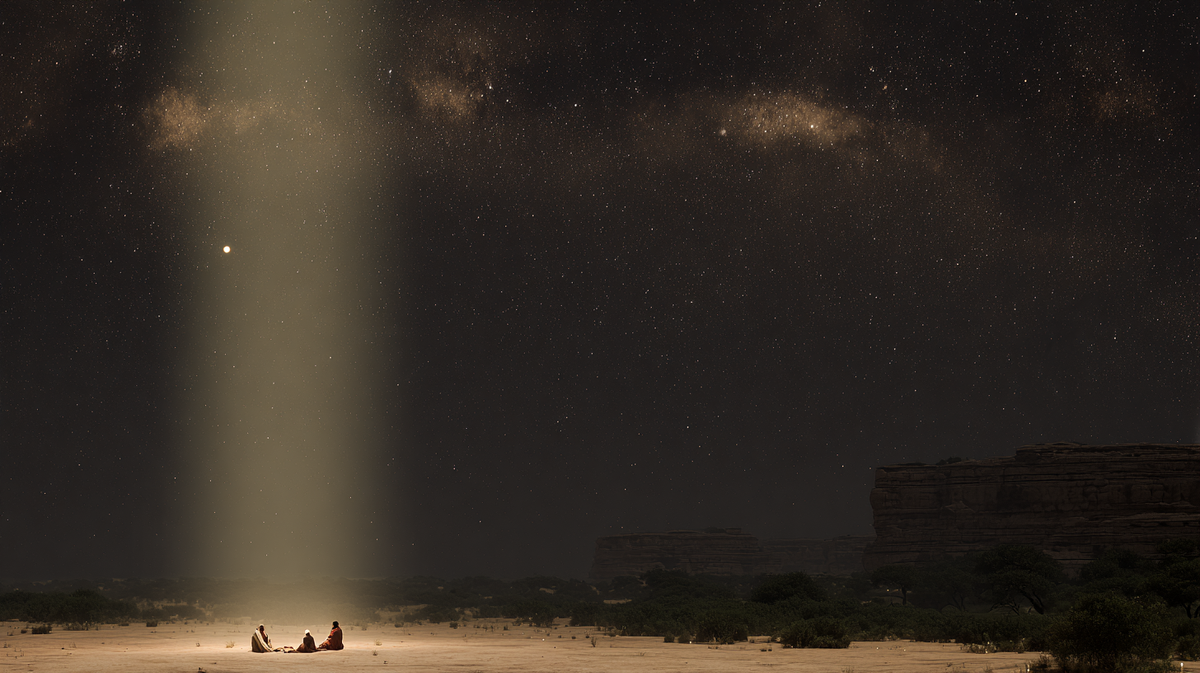Star People

Introduction
Across continents and millennia, Native and First Peoples describe teachers from the sky. They are called Star People, Sky Beings, Star Nation, Ancestors of Light, or by names held within each community’s own language.
These stories speak of visitors who arrive by light, song, or cloud. They offer guidance on harmony, ecology, and ceremony. Some tales read like astronomy wrapped in myth. Others sound like contact.
What if these accounts are not superstition but carefully protected memories of non-human intelligence meeting humanity in sacred time and space.
A living archive, not a museum
Indigenous knowledge is oral, ceremonial, and place bound. Elders teach that some stories are seasonal. Some are only told in ceremony. A speculative reading should honor that. Rather than “proving” anything, this post asks how a modern NHI frame could respectfully listen to the world’s oldest science: observation, pattern, relationship.
Global motifs of the Star People
- Kinship, not conquest
The visitors are often described as relatives from the sky. They arrive as teachers, not rulers. Reciprocity is the law. - Transmission through dream and song
Contact happens in altered states, vision quests, or through specific songs and dances that “open the sky.” - Places where the sky thins
Plateaus, deserts, mountains, and water edges are common sites. The land is the interface. - Gifts of timekeeping and ethics
Star stories encode calendars, planting cycles, navigation, and teachings on balance.
Selected traditions in the lore
(Presented respectfully and at a high level. Specific ceremonial details remain within communities.)
- Plains and Plateau peoples
Narratives speak of Star People who married into clans, taught lifeways, or arrived in “thunder” and light. The message centers on balance with the buffalo, the winds, and the sky clocks. - Hopi and Puebloan star traditions
Kachina beings and star ways align ritual life to sky cycles. The teaching is about maintaining the covenant between people, land, and cosmos. - Diné (Navajo) and Nightway imagery
Holy People travel in light and sound. Sandpaintings map a cosmology where stars are persons and songs are vehicles. - Mesoamerican sky teachers
Star lore infuses calendars and architecture. Temples act like instruments, focusing light and shadow to keep time with the sky beings. - Polynesian wayfinding
The ocean is a star mirror. Navigation knowledge is relational and living. In some tellings, sky ancestors guide the canoes by dream and sign. - Andean star lineages
Mountains are persons and the Milky Way is a river. Pilgrimage, music, and offerings keep the human and more-than-human worlds in dialogue. - Australian First Nations sky country
Songlines connect land to star stories. The night sky is a law book in motion. Contact happens through right relationship.
(Many communities keep specific names, protocols, and stories private. When curious, listen to authorized culture keepers and support Indigenous voices.)
Contact modalities in Indigenous frames
- Lightcraft and cloud vehicles
Visitors descend in luminous forms, clouds, or pillars of fire. - Sound, rhythm, and vibration
Drums, rattles, chants, and breath synchronize attention to the “other side” of the world. - Dreamtime and vision
Consciousness is the medium. Encounters are navigated with guides, offerings, and intention. - Relational protocols
Gifts are exchanged. Agreements are made. The measure of truth is whether life renews.
Why these stories persist
- Encoded astronomy
Star tales carry precise cycles. Knowledge survives by being woven into memorable, sacred stories. - Safeguards against misuse
Ceremonial framing protects power from exploitation. - Proof through effect
If teachings maintain abundance and community health, the story is real in practice.
NHI(Non-human Intelligence) through an Indigenous lens
If we overlay today’s NHI frame on these traditions, a picture emerges:
- The visitors act like field ecologists
They intervene sparingly. They teach feedback, limits, and reciprocity. - Consciousness as interface
Ceremony tunes signal and noise. The “technology” is attention coupled to place. - Sites as instruments
Sacred mountains, kivas, and stone works operate like resonators or antennas that sync human cycles to cosmic ones. - Memory as protocol
Oral law preserves operating instructions without exposing sensitive details.
Ethical note for modern seekers
Approach with humility. Support Indigenous scholars, artists, and land back efforts. Do not extract ceremonies. Ask how your curiosity can become reciprocity.
What If
What if “Star People” is not metaphor but a precise descriptor for neighbors who move through light and intention.
What if humanity’s first contact already happened, and the elders have been patiently holding the door open, waiting for the rest of us to remember how to walk through.
Comments ()